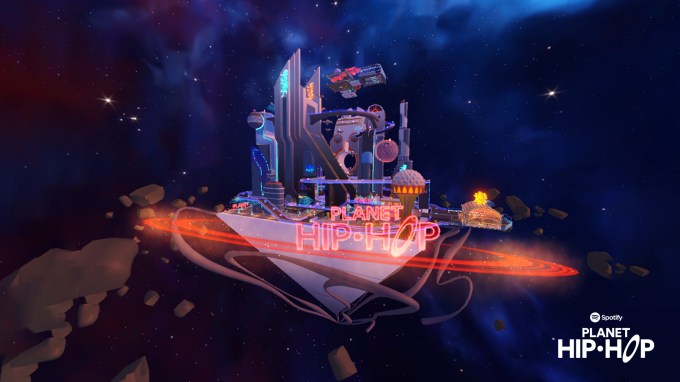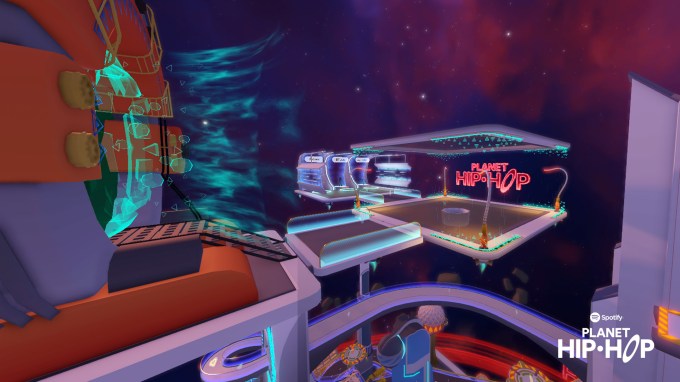EU lawmakers are moving in on the metaverse and making it plain that, whatever newfangled virtual world/s and/or immersive social connectivity that tech industry hype involving the term may refer to, these next-gen virtual spaces won’t escape one hard reality: Regulation.
There may be a second metaverse certainty too, if the Commission gets its way: Network infrastructure taxes.
The EU’s internal market commissioner, Thierry Breton, said today it believes some of the profits made in an increasingly immersive software realm should flow to providers of the network backbone required to host these virtual spaces — a suggestion that’s sure to trigger a fresh round of net neutrality pearl-clutching.
The Commission has been signalling for some months that it wants to find a way to support mobile operators to expand rollouts of next-gen cellular technologies — via imposing some kind of a levy on U.S. tech giants to help fund European network infrastructure — following heavy lobbying by local telcos.
Last week, Breton revealed it plans to consult on network infrastructure cost contribution ideas in Q1 next year — as part of a wider metaverse-focused initiative, with the latter proposal coming later in the year.
More details of the bloc’s thinking on fostering development of virtual spaces and the network pipes needed to connect them has emerged today.
EU initiative on virtual worlds
In a Letter of Intent published today, setting out the bloc’s policy priorities for 2023 — and accompanying her annual State of the European Union speech — the EU’s president, Ursula von der Leyen, confirmed the Commission will put forward an “Initiative on virtual worlds, such as metaverse” next year.
The letter offers scant details on what exactly will be inside the EU’s virtual worlds package. But Breton — via a blog post on LinkedIn of all places — has picked up the baton to flesh out his views on how to deal, in broad-brush policy terms, with (the) metaverse(s) — something he couches as “one of the pressing digital challenges ahead of us.”
Breton presents his remarks as “Europe’s plan to thrive in the metaverse.” Though it remains to be (officially) confirmed whether he’s flying a little solo here — or playing advanced messenger on the direction of next year’s initiative. (We asked the Commission for more on the forthcoming virtual worlds initiative but with so much EU action today our contact warned there could be a delayed response — before pointing back to Breton’s blog, suggesting he is indeed signposting where the bloc is headed on virtual worlds.)
First up, both Breton (at length) and von der Leyen (in passing) are clear in planting a regulatory stake in virtual ground — by pointing out that would-be metaverse monopolists will have to contend with existing EU rules, such as the recent major EU digital rule reboot.
Rebooted digital rules
In her letter penned in difficult geopolitical and economic times, von der Leyen urges the bloc to stay the course on the green and digital transitions — which formed a key plank of her policy plan when she took up her mandate at the end of 2019. “This is about building a better future for the next generation and making ourselves more resilient and more prepared for challenges to come,” she writes, encouraging EU institutions to stick with the transformative push for sustainability and digitalization and implement key pieces of the plan already agreed on.
“This includes implementing the landmark agreements on the Digital Markets Act (DMA) and the Digital Services Act (DSA) which saw the EU take global leadership in regulating the digital space to make it safer and more open,” she goes on, name checking two big components of the digital reboot agreed by the EU’s institutions earlier this year — before adding a further nod to what else may be coming: “We will continue looking at new digital opportunities and trends, such as the metaverse.”
In his blog post, Breton makes it even more plain that metaverse builders are already subject to EU rules. “With the DSA and DMA, Europe has now strong and future-proof regulatory tools for the digital space,” he writes, pointedly adding: “We have also learned a lesson from this work: We will not witness a new Wild West or new private monopolies.
“We intend to shape from the outset the development of truly safe and thriving metaverses.”
This conviction was doubtless cemented by Facebook’s corporate pivot last year to Meta — a self-declared “metaverse company” — as the tech giant sought to escape years of operational scandals and reputational toxicity stuck like a barnacle to its social media brand by deploying a crisis PR rebranding tactic that implies a pivot, without it having to make meaningful reform to its business or business model.
While no one can say for sure whether the metaverse will ever exist (or merely remain an amorphous marketing label), should anything of substance actually materialize it’s pretty clear it won’t be located that far away from the kind of social connectivity Meta already monetizes through mass surveillance-based profiling and behavioural ads. So it seems a safe bet Zuckerberg is hoping to bankroll Facebook’s ‘metaverse’ future via plenty of user-profiling and behavioral ads too, at least in large part.
But if the Facebook founder was betting on a little corporate rebranding exercise to get Meta ahead of pesky regulators — such as privacy watchdogs in Europe that are finally starting to land some sizeable lumps on the company — he may be disappointed to find virtual worlds aren’t an escapist paradise after all.
A Commission spokesperson told TechCrunch: “The Commission is closely monitoring potential specific legal issues, such as defining the applicable law in various ongoing interactions and transactions by metaverse participants (including anonymous participants or those coming from third countries), liability questions or issues around digital assets.”
“The European regulatory framework (with the DSA, DMA and future AI and Data Acts) is also being revamped to address the challenges of the digital space and will ensure that users are protected and that SMEs can benefit from market developments and are not driven out of the market by abusive behaviours by gatekeepers, regardless of the technology used,” the spokesperson further noted.
Out with the old growth playbook
Taken as a whole, Breton’s remarks suggest the EU will be coming with a blended ‘sow and scythe’ package for virtual worlds — offering support initiatives (to encourage development and infrastructure) but also warnings that it will step in actively to steer and shape development, to ensure any new wave of ever-more-immersive socio-digital spaces don’t just repeat the same toxic growth playbook as Facebook.
Key EU preoccupations here appear to be enforcing user-centric safety issues (such as in areas like content moderation); and ensuring platforms remain open and contestable to the whole market (via mandating interoperability standards).
“Our European way to foster the virtual worlds is threefold: People, technologies and infrastructure,” Breton writes, summarizing the planned approach. “This new virtual environment must embed European values from the outset. People should feel as safe in the virtual worlds as they do in the real one.
“Private metaverses should develop based on interoperable standards and no single private player should hold the key to the public square or set its terms and conditions. Innovators and technologies should be allowed to thrive unhindered.”
There is also a reference to launching a “creative and interdisciplinary movement” — with the goal of developing “standards, increas[ing] interoperability, maximising impact” — a movement Breton says he wants to involve IT experts, regulatory experts citizens’ organisations and youth, in a similar fashion to the new European Bauhaus initiative the EU has applied to encourage engagement with sustainability-focused ‘green deal’ goals.
This piece of the EU plan contrasts to the more single-minded focus of Meta president (and former EU lawmaker), Nick Clegg, who — in his role evangelizing metaverse for Meta — has spent a lot of words talking up the volume of developer jobs that will be needed to build the immersive future Meta is betting its corporate continuity on.
Breton’s point appears to be that the EU wants a far more diverse mix of expertise to be involved in any ‘metaverse’ development. (Or, tl;dr: ‘We all know what happens when tech worlds are built, owned and operated by too many techbros — and we sure don’t want a repeat of that!’)
Ecosystem support — and infrastructure taxes?
A second big chunk of Breton’s blog post focuses on the technologies and tech skills the Commission sees as necessary for the bloc to have the power to bend virtual world makers to “European values.”
Breton notes these span many areas — of “software, platforms, middleware, 5G, HPC, clouds, etc.” — but with “immersive technologies and virtual reality” identified as being “at the heart” of the metaverse “phenomenon.” So immersive tech looks to be where the EU will direct the meatiest ecosystem support in the forthcoming virtual worlds package.
But for starters Breton has announced the launch of a VR and AR industry coalition.
“The Commission has been laying the groundwork to structure this ecosystem,” he writes. “Today, I am happy to launch the Virtual and Augmented Reality Industrial Coalition, bringing together stakeholders from key metaverse technologies. We have developed a roadmap endorsed by over 40 EU organisations active in this space, from large organisations to SMEs, and universities.”
On this a Commission spokesperson pointed us to a strategic paper it commissioned ahead of launching the VR/AR industrial coalition — also telling us: “The objective is to support the uptake of XR [extended reality] technologies for industrial applications and use cases in key sectors such as construction, manufacturing, health, media and education. European projects have fostered a European XR community including user industries, researchers, solution providers, content creators, as well as national and regional hubs. In the cycle 2023-2024, the Commission will inter alia further support specifically the development and integration of advanced XR hardware components as well as the development of new solutions for creating virtual worlds and 3D models, realistic avatars and intelligent agents.”
Breton’s post goes on to give a nod to the European Chips Act — which aims to mobilize public and private investment to drive on-shore semiconductor manufacture in a supply chain resilience and digital sovereignty drive — with the commissioner recognizing that hardware development and production is a core component for virtual worlds, underpinning its development (and, ultimately, most likely, determining whether immersive technologies like VR and AR remain a niche (sometimes) nausea-inducing pastime for the geeky few or actually make the leap into a transformative mainstream medium).
“The next step will be a quantum leap from current virtual reality and other enabling technologies to a world that truly blends the real with the virtual,” pens Breton, a former telco exec, in full tech evangelist mode.
The EU commissioner saves the most controversial piece of the upcoming metaverse plan for last: A plan for infrastructure taxes to come down the policy pipe. And he confines himself to trying to tamp down any objections by laying out a case for some form of levy to fund the necessary connectivity — aka the high-capacity, high-bandwidth, high-speed, low-latency networks we’re told will be needed to sustain these hyper immersive virtual spaces we’re also told we’ll want to pause our off-line existence to spend time in.
There are no firm details on what the EU is proposing on virtual world taxes as yet — just an affirmation that a consultation is coming down the pipe.
“The current situation, exacerbated during the COVID pandemic, shows a paradox of increasing volumes of data being carried on the infrastructures but decreasing revenues and appetite to invest to strengthen them and make them resilient,” writes Breton, drawing on long-standing telco gripes about scale of network investment demanded to roll out techs like 5G vs dwindling returns.
“The current economic climate sees stagnating rewards for investment and increasing deployment costs for pure connectivity infrastructure,” he goes on. “In Europe, all market players benefiting from the digital transformation should make a fair and proportionate contribution to public goods, services and infrastructures, for the benefit of all Europeans.”
Case made, Breton ends by trailing what he couches as a “comprehensive reflection and consultation on the vision and business model of the infrastructure that we need to carry the volumes of data and the instant and continuous interactions which will happen in the metaverses” — thereby landing a second blow of his case-hammer backing metaverse infrastructure taxes.
Still, you have to admire the EU’s repurposing of the tech industry’s latest shiny new hype vehicle to truck back the other way and deliver an age-old demand for a revenue share.
This report was updated with responses from the Commission re: the upcoming virtual worlds initiative
Europe wants to shape the future of virtual worlds with rules and taxes by Natasha Lomas originally published on TechCrunch

Powered by WPeMatico






 (@cooldooski)
(@cooldooski) 
 way to foster the virtual worlds builds on:
way to foster the virtual worlds builds on:  people
people

